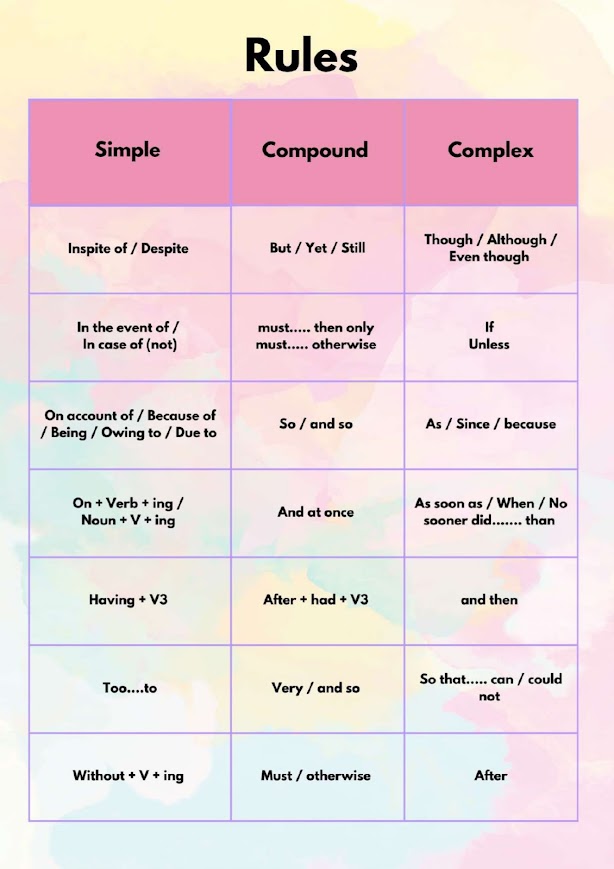Transformation of Sentence
1. Active to Passive Voice Transformation
Introduction
- Define active and passive voice.
- Importance of understanding passive voice in academic and professional writing.
Explanation of Transformation
- Step-by-step guide to transforming active to passive voice.
- Examples with different verb tenses (present, past, future).
Usage and Applications
- When to use passive voice (emphasizing the action rather than the doer, formality, object focus).
- Examples from literature, news, and technical writing.
Common Mistakes and Challenges
- Errors to avoid when transforming sentences.
- How to maintain clarity and coherence in passive constructions.
Conclusion
- Summarize the benefits of mastering passive voice transformation.
- Importance in improving writing style and versatility.
2. Direct to Indirect Speech (Reported Speech)
Introduction
- Define direct and indirect speech (reported speech).
- Significance in narrative writing and journalism.
Explanation of Transformation
- Steps to convert direct speech into indirect speech.
- Handling changes in tense, pronouns, and adverbs.
Context and Examples
- Real-world examples of direct and indirect speech in interviews, stories, and dialogue.
- Variations based on reporting verbs and sentence structures.
Implications and Nuances
- Cultural and contextual differences in reporting speech.
- Impact on narrative flow and character development.
Practical Tips and Applications
- Techniques for integrating indirect speech seamlessly into writing.
- Enhancing authenticity and credibility in dialogue.
Conclusion
- Reflect on the role of indirect speech in storytelling and communication.
- Tips for effective usage and improving narrative coherence.
3. Active to Emphatic Structure
Introduction
- Definition of emphatic structure in English grammar.
- Purpose and impact of using emphatic structures.
Transformation Process
- Steps to transform active sentences into emphatic structures.
- Examples showcasing different emphatic forms and their effects.
Usage and Effectiveness
- Advantages of using emphatic structures for emphasis and clarity.
- Comparisons with other forms of sentence restructuring.
Challenges and Solutions
- Common pitfalls in constructing emphatic sentences.
- Strategies for maintaining natural flow and readability.
Literary and Practical Examples
- Excerpts from literature and speeches demonstrating emphatic usage.
- Application in persuasive writing and public speaking.
Conclusion
- Summarize the benefits of mastering emphatic sentence transformations.
- Practical advice for integrating emphatic structures into writing.
4. Question to Statement Transformation
Introduction
- Overview of interrogative and declarative sentences.
- Importance of transforming questions into statements in various contexts.
Transformation Techniques
- Methods for converting questions into statements (reordering, changing verb forms).
- Examples illustrating transformations across different question types.
Functional Applications
- Situations where statement transformations are necessary (interviews, academic writing).
- Enhancing clarity and directness in communication.
Cultural and Linguistic Variations
- Differences in question-statement transformations across languages.
- Impact on cross-cultural communication and understanding.
Best Practices and Considerations
- Tips for maintaining grammatical accuracy and coherence.
- Addressing common challenges in sentence transformation.
Conclusion
- Reflect on the versatility and utility of question-statement transformations.
- Strategies for mastering this skill in everyday communication.
5. Comparative to Positive/Negative Transformation
Introduction
- Definition and significance of comparative and positive/negative sentence forms.
- Practical applications in descriptive and evaluative writing.
Transformation Techniques
- Steps for converting comparative sentences to positive or negative forms.
- Examples highlighting changes in structure and meaning.
Contextual Usage
- When to use positive/negative transformations for clarity and emphasis.
- Examples from academic, advertising, and argumentative writing.
Impact on Communication
- How sentence transformations influence reader perception and understanding.
- Strategies for conveying nuanced comparisons and contrasts.
Avoiding Ambiguity and Confusion
- Common pitfalls in comparative transformations.
- Techniques for maintaining precision and coherence.
Conclusion:
- Summarize the benefits of mastering comparative transformations.
- Practical advice for improving sentence structure and rhetorical effectiveness.
Each section would delve deep into the mechanics, rationale, examples, and practical applications of transforming sentences into different forms, offering comprehensive insights and guidance for effective communication in various contexts.




Comments
Post a Comment